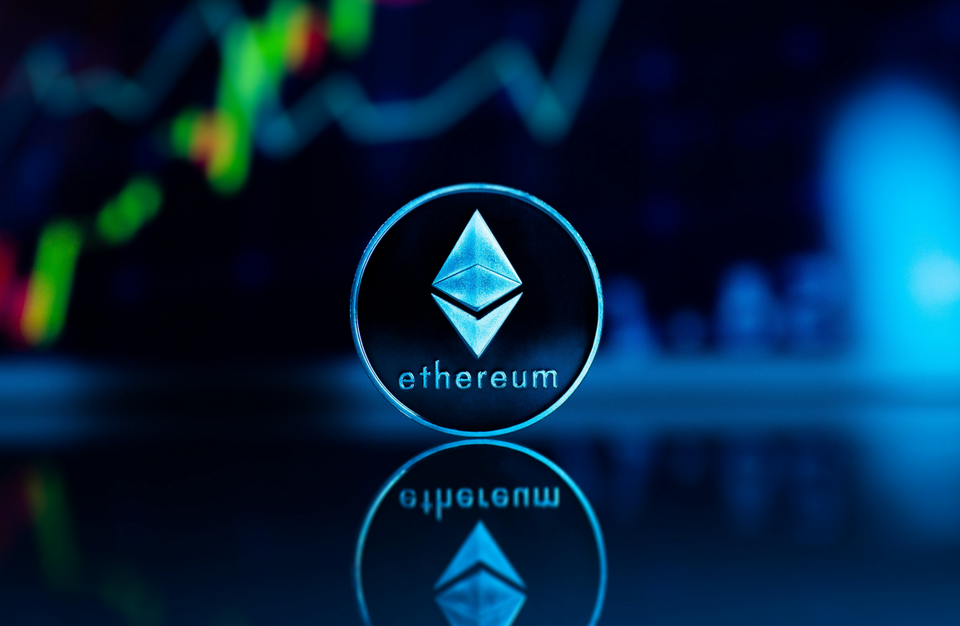Ethereum Spot Disappearance
Spot Ethereum has become increasingly scarce, making derivatives preferred instruments for trading. Reduced availability of the underlying asset may lead to abnormal price moves, which are not priced in the current low-volatility environment.
Futures conundrum
Ethereum is increasingly traded via futures rather than on the spot market. According to The Block, Ethereum spot to futures trading volume ratio has almost halved since the beginning of this year.
Ethereum spot to futures trading volume ratio (30-day moving average)
Bitcoin trading volume trend is exactly the opposite. Crypto traders increasingly prefer to trade spot Bitcoin rather than Bitcoin futures. According to The Block, Bitcoin spot to futures trading volume ratio has doubled since the beginning of this year.
Bitcoin spot to futures trading volume ratio (30-day moving average)
In USD terms, Ethereum futures trading volume is close to Bitcoin futures volume, despite Ethereum's market cap being twice smaller than Bitcoin’s.
Bitcoin and Ethereum futures 24-hour trading volume (USD billion)
Source: Coinglass
Ethereum scarcity
It seems that spot Ethereum has become scarcer, making derivatives a preferable trading venue. Indeed, I see several factors reducing the available amount of Ethereum.
The Merge has led to a dramatic decline of Ethereum's new supply. The official site of Ethereum (ethereum.org) estimates that annualized issuance rate has dropped from 4.61% before the Merge to 0.52% after the Merge.
The burn mechanism, which was introduced by the EIP-1559 protocol in August 2021, continues to reduce the amount of Ethereum. As a reminder, the EIP-1559 protocol requires to burn Ethereum used to pay base gas fees.
Thus, Ethereum supply basically stopped rising after the Merge. That is expected and even has been regarded as a desirable outcome of the Merge.
Ethereum supply
Meanwhile, the amount of staked Ethereum continues to grow, further decreasing the amount available for exchange.
Ethereum total amount staked
A new trading regime
The trends mentioned in the previous chapter (lower new supply, continued burning, and increasing staking) will continue at least in the next few months and probably even extend to a few quarters. The relative scarcity of spot Ethereum may stop only when staked Ethereum is released, which is likely months or quarters ahead.
Thus, I believe that Ethereum enters a new trading regime accompanied by relatively low illiquidity of the spot segment and dominance of derivatives trading. To be clear, in traditional finance derivatives are often traded much more than underlying assets, but the underlying assets are still freely available for trading and for arbitrage vs futures. For example, the trading volume of the E-Mini S&P 500 futures is about 10 times bigger than the trading volume of the largest S&P 500 ETF (SPY, SPDR S&P 500 ETF Trust), but there is no “staked” SPY unavailable for trading.
I think that many crypto traders stake their Ethereum and hedge via futures. It is a rational way to earn interest with little volatility, but on a system-wide level, it creates vulnerability, particularly if a large amount of these positions is leveraged. If Ethereum price goes up a lot, these traders will face margin calls. Their balance sheet would remain sound, but they would have a liquidity issue. There is a mismatch between futures featuring continuous margin checks and near-frozen staked coins.
The practical implication of the new regime may be an increased probability of outsized price moves. Current options prices do not reflect such risks, as implied volatility is subdued, tracking very low historical volatility.
Ethereum DVOL index
How to trade it
The most obvious way to exploit the new trading regime is to go long Ethereum implied volatility vs Bitcoin implied volatility (of course, such trades are for sophisticated investors only). However, the ratio of Ethereum implied volatility to Bitcoin implied volatility has already increased to a level slightly higher than on September 14 (just before the Merge). The ratio is 1.52 as of November 7 compared with 1.49 as of September 14 (based on DVOL indexes). The ratio was as low as 1.1 in the beginning of May (before volatility skyrocketed on the Luna failure news) and about 1.2 a year ago. Also, there may be other factors affecting ETH/BTC price and volatility. I think that if spot Ethereum will continue losing liquidity, the ratio will go even higher, but I’m not sure about chasing the ratio higher right now.
An easier way to use the new regime is getting some volatility exposure to Ethereum, possibly swapping a part of Ethereum holdings into a long position in options with the same delta exposure. Also, I would consider a very small long position in lottery-type deep out-of-money calls on Ethereum (particularly for traders staking their coins and shorting futures).
*This communication is intended as strictly informational, and nothing herein constitutes an offer or a recommendation to buy, sell, or retain any specific product, security or investment, or to utilise or refrain from utilising any particular service. The use of the products and services referred to herein may be subject to certain limitations in specific jurisdictions. This communication does not constitute and shall under no circumstances be deemed to constitute investment advice. This communication is not intended to constitute a public offering of securities within the meaning of any applicable legislation.




